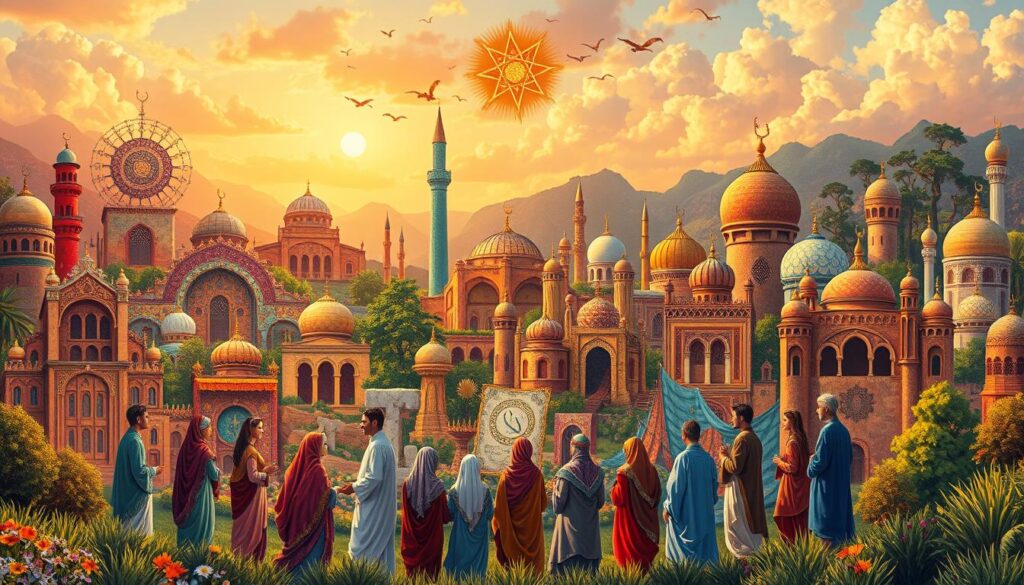Understanding Muslims’ views on other religions is key in our diverse world. Islam sees religion as guidance from Allah, given through many messengers, from Adam to Muhammad (pbuh). With 1.9 billion Muslims worldwide, which is about 24% of all people, it’s vital to understand Muslim viewpoints on different faiths. This helps promote tolerance and respect, as Islam teaches.
The Quran mentions many faiths, showing how important it is to understand each other. It says in Surah 2:62 that Jews, Christians, and Sabians will be rewarded if they believe in God and do good. This message, and others like Quran 49:13, tell Muslims to value our world’s diverse cultures. This helps everyone get along and understand each other better.
Prophet Muhammad (pbuh), a major figure in history, showed love and kindness to everyone. This includes people of other faiths. Studies, like one from Pew Research in 2017, show most Muslims think talking about different religions is important. This helps everyone learn and get along.
Looking into Islamic views on different faiths shows us how important kindness and community are. By talking respectfully about what we share, we can face problems like religious extremism together. This way, we build a peaceful world for everyone.
Key Takeaways
- Islam promotes respect for religious diversity as a foundational principle.
- The Quran emphasizes kindness and peaceful interactions with non-Muslims.
- Interfaith dialogue is considered crucial for fostering understanding and cooperation.
- The teachings of the Prophet Muhammad (pbuh) protect the rights of non-Muslims.
- Global connections and dialogue can enhance social harmony and cultural appreciation.
Understanding Islamic Teachings on Religious Diversity
Islamic teachings highlight the value of diversity and urge us to respect different beliefs. The Quran promotes a message of tolerance, showing us how to live with compassion and peace. This helps build understanding among various religions.
The Quran’s Message on Tolerance
The Quran has many verses urging us to treat others with respect. One important verse is Surah Al-Baqarah (2:256), which says,
“Let there be no compulsion in religion.”
This powerful message teaches us to accept different beliefs and ways of living.
Billions are inspired by this call for tolerance. Studies show that in places like sub-Saharan Africa and South Asia, almost 80% of Muslims see their faith as key to their lives. This deep faith drives them to follow Islam’s teachings on respecting everyone, no matter their background.
Key Hadiths Promoting Respect
The Hadith, too, stresses the importance of respecting others, with sayings from the Prophet Muhammad (peace be upon him). One Hadith tells us to be kind and caring to everyone. This supports the idea of peaceful relationships between different faiths.
These lessons continue to influence how we view religious diversity today. It’s our duty to maintain an inclusive society, encouraging connections. This shows our dedication to peace and respect between all religions.
Historical Context of Islam and Other Religions
Islam, Judaism, and Christianity have influenced each other over time. Despite some tense moments, there’s been a lot of working together. Historical interfaith dialogue was common in the Islamic Golden Age, bringing people together to share knowledge.
Interactions with Judaism and Christianity
Islam’s story with Judaism and Christianity is full of different moments. The Constitution of Medina showed early teamwork, with Jews keeping their traditions for political support. This deal helped keep many traditions alive under Muslim leaders. Also, there were times when leaders were more open, like the Umayyads and Abbasids.
- Jews, Christians, and Zoroastrians were seen as “People of the Book.” They got protections to practice their religion and follow their family laws.
- Muslim men could marry women from these faiths, but not the other way around.
- The situation changed depending on the leaders. Some, like Mughal Emperor Akbar, pushed for tolerance.
The Role of the Islamic Golden Age
The Islamic Golden Age was a key time for Muslim interactions with other religions. It was a great period for learning, art, and culture, helping to bring different religions closer. These interactions focused on shared values and peaceful coexistence.
| Aspect | Details |
|---|---|
| Religious Tolerance | Muslims engaged in extensive interfaith dialogue, allowing major faiths to coexist. |
| Intellectual Exchange | Advancements in science and philosophy were shared and developed collectively. |
| Legal Structures | The jizyah tax and protections for non-Muslims facilitated smoother cohabitation. |
| Social Dynamics | Significant cultural exchanges promoted mutual respect among faiths. |

The Concept of ‘People of the Book’
The term “People of the Book” is very important in Islam. It mainly talks about Jews and Christians. They are seen in the Quran as groups that got messages from God. This idea helps us understand how non-Muslims are seen and treated in Islamic laws. It also highlights respect for shared beliefs.
Definition and Importance
The meaning of People of the Book goes further in Islamic teachings. It shows that Jews, Christians, and Sabians have a special spiritual place. They are promised safety and help in the Quran (Sūrat al-Baqara 2:62). This group sometimes includes Zoroastrians and others, but not everyone agrees. These communities are often called dhimmi. This means they must pay a tax named jizya.
This classification is vital for Muslims. It helps build a stronger community feeling and understanding. The Quran also says there should be no force in religion (Al-Baqarah 2:256). This means we should treat each other with respect and kindness.
Treatment of Non-Muslims in Islamic Law
Islamic law treats non-Muslims with protection, respect, and a desire to live together peacefully. History shows that Muslims did not make others change their religion by force. They let Jews, Christians, and other minorities follow their faiths freely. This included keeping their places of worship safe.
The Quran encourages living in peace and being kind to those who do not fight you (Al-Mumtahana 60:8). Some conflicts happen because of economic or political reasons, not faith. Islamic teachings stress that we should respect People of the Book. We recognize their important spiritual role.
Modern Islamic Perspectives on Other Faiths
In today’s talks, Islamic scholars share different views on interacting with other faiths. These opinions show a range of thoughts on religious inclusivity in Islam. Many modern Muslim views support dialogue and respect among different faiths. This is based on the belief that every nation was given guidance by their prophets, as the Qur’an says: “And We did raise among every people a Messenger” (Ch. 16: V. 37).
Views from Prominent Islamic Scholars
Top scholars stress kindness and respect towards people of other faiths. They point to the Qur’an, which says, “There should be no compulsion in religion” (Ch. 2: V. 257). This idea is crucial for creating friendly relationships with different religions. Scholars push for open talks, stating we should “call unto the way of thy Lord with wisdom and goodly exhortation” (Ch. 16: V. 126). This approach helps us understand each other better.
Different Interpretations within Various Schools of Thought
Islamic thought spans from traditional to modern. The four main schools of Islamic law—Shafi’i, Maliki, Hanafi, and Hanbali—have their own views on interfaith relations. While some traditionalists are careful about outside views, modernists often welcome a more inclusive approach. This shows Islam’s wide-range interpretation of religious inclusivity. It underlines the importance of cooperation and peace in today’s connected world.

For hands-on advice on connecting with non-Muslims, resources like this guide offer great tips for positive interfaith relations.
The Role of Interfaith Dialogue
In today’s world, talking with people of other faiths is crucial. Through open talks, we grow to understand and respect different beliefs. This helps us build bonds, share important values, and tackle challenges together, making our communities better.
Examples of Successful Interfaith Initiatives
There are many great examples of interfaith work. Here are a few:
- Nigerian Inter-Religious Council (NIREC): This group shows how working together can help solve big problems like poverty and unfairness, building trust between different communities.
- Interfaith Bus Tour at Texas Christian University (TCU): Here, about 30 students learn about various faiths by visiting places like a Jewish synagogue and a Hindu temple. This helps them appreciate different beliefs better.
- Iftar meals during Ramadan and Passover Seders: These events bring Muslim and Jewish students together. They foster friendship and are supported by groups such as the Muslim Student Association and TCU Hillel.
Benefits of Open Conversations
Interfaith talks offer more than just personal connections. They also help our communities grow in big ways. Here are some key benefits:
- Breaking Down Stereotypes: Talking helps get rid of wrong ideas about Islam and other faiths, leading to a more respectful world.
- Community Engagement: When we work on projects like gardens and food pantries together, it brings different people together and creates a strong sense of community.
- Policy Influence: Interfaith discussions can inspire action to protect the rights of religious groups, making sure laws support fairness and freedom of belief.
- Educational Growth: Schools and community centers host events that teach us about respecting different faiths, helping everyone learn and grow.
- Global Peace Efforts: The UN acknowledges how important these conversations are for world peace, showing how religious leaders can help make the world a better place.
Common Misconceptions About Islam and Other Religions
There are many misconceptions about Islam that can blur what this faith truly stands for. It’s crucial to know the difference between myths and the real teachings. This can help us understand each other better. Wrong stories can create harmful stereotypes. By learning and talking to one another, we can overcome these misunderstandings.
Myths vs. Facts
Many myths about Islam come from cultural confusion and historical events that people misinterpret. One common myth is that Islam supports violence or that most Muslims are extremists. But, the truth is the vast majority of Muslims – about 1.2 billion people – have a wide range of beliefs and traditions. Only a tiny fraction of terrorist acts in the U.S. since 9/11 were done by Muslims, only 2%. Also, around 70% of Muslims see their religion as promoting peace. This big difference shows how dangerous stereotypes can be.
How Stereotypes Affect Understanding
Negative images of Islam can shape what people think. A study found that over 60% of non-Muslims in the U.S. believe at least one unfair stereotype about Muslims. Many Muslim Americans, 50% of them, felt they were treated poorly after 9/11. This shows we urgently need to teach people more about Islam. When people get to know each other from different backgrounds, it leads to a kinder, more welcoming world.

| Stereotype | Reality |
|---|---|
| Muslims are violent | Only 2% of terrorist acts in the U.S. since 9/11 have been committed by Muslims. |
| Islam opposes women’s rights | 87% of Muslim women in the U.S. feel they have the same rights as men in religious practice. |
| Most Muslims support extremism | 70% of Muslims worldwide view their religion as a force for peace. |
| Muslims do not believe in religious freedom | 65% of Muslim-majority countries have constitutional protections for freedom of religion. |
Education and open dialogue give us a chance to change the story. By talking and learning about these stereotypes, we can bring about positive change. This leads to a friendly and growing community.
The Influence of Culture on Religious Views
Culture shapes how Muslims see their faith and others’ beliefs. We see interesting variations in Muslim community perspectives around the world. This shows how closely religion and local customs are linked.
Variations Across Different Muslim Communities
Muslims worldwide have diverse beliefs, shaped by geography and history. The global Muslim population is about 1.5 billion. About 900 million live in 30 Asian and African countries. Here, local traditions mix with Islamic beliefs, making unique views on sharia law.
Some regions accept and blend regional religious pluralism with Islam. This mix includes pre-Islamic customs. Sometimes, this blend leads to confusion about what is truly Islamic. Cultural habits, from food to rituals, are seen as Islamic but may not be based on Quranic teachings.
Regional Perspectives on Religious Pluralism
In the U.S., with about 1,250 mosques, Muslims adapt to local culture. Despite many Americans not knowing much about Islam, this encourages dialogue between different faiths.
Research shows how culture affects Islamic views and interactions. By exploring this, we understand how location and society impact acceptance of various beliefs. See the studies here.
Understanding these differences helps us see how culture influences Muslim views. It shows why regional engagement is key to respect and tolerance.
Contemporary Challenges to Religious Tolerance
Today, religious tolerance is at a turning point. It’s up against many modern challenges. The increase of extremism and unfair practices shows we need more understanding among different faiths. Today’s religious conflicts expose the complicated relationships that affect peace worldwide.
Instances of Religious Conflict
Looking at recent data, we see worrying trends in religious conflicts. From 2007 to 2017, more governments started to limit religious freedoms. The number of countries with high religious tensions went up from 39 to 56. This shows the growing problem of these tensions.
For example, a study found that, by 2017, 19 out of 20 countries in the Middle East-North Africa favored one religion. This makes things hard for religious minorities in those countries.
- The global score for laws against religious freedom rose by over 20% in that decade.
- In Europe, government restrictions on religious activities doubled since 2007.
- In the Middle East-North Africa region, government harassment of religious groups jumped by 72%.
- Even though violence linked to religious tensions fell by about 37%, challenges still remain.
Efforts to Promote Unity and Peace
We all have a job in tackling these modern challenges. Many groups work to promote unity in our diverse world. They aim to bring peace. Around 45% of people in Muslim-majority countries think interfaith dialogue is key. It builds respect and understanding.
Islamic teachings also push for tolerance. The Quran says “there is no compulsion in religion” (Surah Al-Baqarah, 2:256). This helps build a base for tolerance.
| Year | Governments Imposing Restrictions | Countries Experiencing Social Hostilities | Decrease in Religious Violence |
|---|---|---|---|
| 2007 | 40 | 39 | 91 |
| 2017 | 52 | 56 | 57 |
| Change | +12 | +17 | -34 |
We should all support efforts to bring peace and unity among different faiths. By accepting our differences, we can aim for a future full of religious understanding and respect.
Education and Religious Understanding
Education is vital in building bridges between different faiths. Schools play a key role by teaching students about various religions. This helps grow respect and appreciation for diversity among students.
The Role of Religious Education in Schools
Schools are crucial in teaching students about different cultures and beliefs. By including religious education, they help students understand and respect others. This makes our communities more inclusive and peaceful.
- Dynamic curricula that incorporate multi-faith approaches.
- Programs fostering respect for religions among students.
- Engagement in community service projects that include interfaith cooperation.
Programs Encouraging Religious Literacy
Teaching religious literacy helps to clear up misunderstandings. Universities like Hartford International University offer programs on different faiths. This teaches students to appreciate and respect various religious traditions.
There are key benefits to quality religious education:
| Educational Aspect | Impact |
|---|---|
| Religious literacy programs | Encourages respectful dialogue among students from different backgrounds. |
| Interreligious studies | Promotes understanding of other faiths as essential for harmony. |
| Protestant missionary education | Significantly improved literacy, particularly for women in sub-Saharan Africa. |
| Islamic educational institutions | Advanced scholarship and knowledge sharing, such as in Baghdad’s House of Wisdom. |
We aim for a world where everyone values each other’s beliefs. Through education, we can build a more understanding and compassionate society. This is how we respect and celebrate our differences.
The Future of Interreligious Relations
The future of talking between different religions shows we need to talk and understand more than before. Cities keep growing with many kinds of people which pushes us to get better at getting along. With respect and understanding, we can work together, making things better for everyone.
Prospects for Continued Dialogue
Imagine a future where young people help connect different faiths. Through kindness and working on projects together, we can bring people closer. Groups like Caritas show that helping others goes beyond our religious beliefs. It’s about our shared values. This approach can make religions work better together and help more people.
Building Bridges for Future Generations
Teaching kids to be kind and respectful can help everyone get along in the future. Adding various religions to education and community work is key. This way, we can change how religions see each other. Our kids will live in a world that loves diversity and works together. By joining hands, we can all hope for a peaceful future where different faiths work as one.






